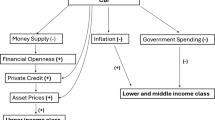Abstract
Economic Growth has been volatile in Pakistan; so is the case with poverty and inequality. It is a matter of great intellectual concern to know why growth has been pro-poor at some occasions of history in some specific regions while anti-poor in other areas. This paper disaggregates Poverty Equivalent Growth Rate (PEGR) at urban–rural sectors of Pakistan and across its provinces to measures growth pro-poorness in both relative and absolute terms from 2001 to 2012. Results show an overall counteracting effect of increased inequality on growth elasticity of poverty at national level but with significant regional contrast. Growth at urban level is found pro-poor (anti-poor) for all poverty measures in relative (absolute) term. This is contrary to the rural regions that experienced anti-poorness in both relative and absolute terms. Growth rate and degree of pro-poorness exhibited inverse relationship during different sub-periods. Sub-national PEGR analysis shows differential pattern of pro-poorness across regions and time. Growth proved relatively pro-poor in Balochistan and Sindh while it turned to be anti-poor in the Punjab and, Khyber Pakhtunkhwa. Though the relative pace of rural poverty reduction is found higher across different provinces, yet rural areas still markedly lagged behind their urban counterparts in terms of growth pro-poorness. This is suggesting relatively fewer growth gains to the rural poor across different regions of the country. A consistent doses of long term pro-poor and distributive policies through fiscal and monetary management can be a workable option to minimize the gap between the rich and the poor.






Similar content being viewed by others
Notes
The monotonicity axiom requires that a poverty measure increases (decreases) whenever the income of a poor person falls (increases). That is, for all x,y ͼ Dn, if xj = yj for all j ≠ I, y ͼ z(x) and xi < yi, then P(y,z) < P(x,z).
References
Akhtar, S. (2008). Trends in regional inequalities in Pakistan: Evidence since 1998. The Lahore Journal of Economics, (Special edition), 205–220.
Anwar, T. (2005). Long term changes in income distribution in Pakistan: Evidence based on consistent series of estimates. Discussion paper no. 3, CRPRID, Islamabad.
Bourguignon, F. (2004). The poverty-growth-inequality triangle. Paper presented at the Indian Council for Research on International Economic Relations, New Delhi, on February 04.
Chaudhry, I. S., Faridi, M. Z., & Hanif, I. (2012). The whimsical trends of rural poverty in Pakistan: Some diversifications. International Research Journal of Finance and Economics, 83, 78–89.
Cheema, I. A. (2005). Revisiting poverty line 2000–200. Discussion paper series no. 2, CRPRID, Islamabad.
Cheema, A. Z., & Sial, M. H. (2012). An assessment of pro-poor growth in Pakistan from 1993 to 2008. Journal of Research in International Business Management, 2(1), 1–9.
Datt, G., & Ravallion, M. (1992). Growth and redistribution components of changes in poverty measures: decomposition with application to Brazil and India in 1980s. Journal of Development Economics, 38(2), 275–295.
Foster, J., Greer, J., & Thorbecke, E. (1984). A class of decomposable poverty measures. Econometrica, 52(3), 761–766.
Gazdar, H. (2004). Labour market and poverty in Pakistan: Institutional arrangements and policy. Working paper no. 2, CRPRID, Islamabad, Pakistan.
Government of Pakistan. (2002). Notification No. 1(41) Poverty/PC/2002 dated 16 Aug. 2002. Planning and Development Division, Government of Pakistan.
Government of Pakistan. (2003). Accelerating economic growth and reducing poverty: The road ahead. Poverty reduction strategy paper, Ministry of Finance, Government of Pakistan.
Government of Pakistan. (2013). Economic survey of Pakistan 2013–2014. Ministry of Finance, Government of Pakistan.
Hussain, A. (1988). Technical change and social polarization in Rural Punjab. In: Strategic issues in Pakistan’s Economic Policy. Lahore: Progressive Publishers.
Jamal, H. (2014). Growth and income inequality effects on poverty: The case of Pakistan (1988–2011). University library of Munich no. 59897, Germany.
Kakwani, N. (1997). On measuring growth and inequality components of poverty with application to Thiland. Discussion paper no. 16, Mimeo, School of Economics, The University of New South Wales, Sydney.
Kakwani, N., & Pernia, E. (2000). What is pro-poor growth. Asian Development Review, 18(1), 1–22.
Kakwani, N., & Son, H. H. (2003). Pro-poor growth: Concept and measurement with country case studies. The Pakistan Development Review, 42(4), 417–444.
Kakwani, N., & Son, H. H. (2008). Poverty equivalent growth rate. Review of Income and Wealth, 54(4), 643–655.
Omer, M., & Jafri, S. (2008). Pro-poor growth in Pakistan: An assessment over the past four decades. South Asian Economic Journal, 9(1), 51–68.
Ravallion, N., & Chen, S. (1997). What can new survey data tell us about recent changes in distribution and poverty? World Bank Economic Review, 11(2), 357–382.
Ravallion, N., & Chen, S. (2003). Measuring pro-poor growth. Economic Letters, 78(1), 93–99.
Saboor, A., & Hussain, Z. (2005). The dynamics of rural poverty in Pakistan: A time series analysis. LJE, 10(1), 1–14.
Shorrocks, A., & Van der Hoeven, R. (Eds.). (2005). Growth, inequality, and poverty. Oxford: Oxford University Press.
Watts, H. (1968). An economic definition of poverty. In D. P. Moynihan (Ed.), Understanding poverty (pp. 316–329). New York: Basic Books.
Zheng, B. (1993). An axiomatic characterization of watts poverty index. Economic Letters, 42(1), 81–86.
Author information
Authors and Affiliations
Corresponding author
Appendix
Rights and permissions
About this article
Cite this article
Ali, I., Barrientos, A., Saboor, A. et al. A Decade of Sub-national Pro-poor Growth in Pakistan. Soc Indic Res 133, 47–65 (2017). https://doi.org/10.1007/s11205-016-1349-7
Accepted:
Published:
Issue Date:
DOI: https://doi.org/10.1007/s11205-016-1349-7





